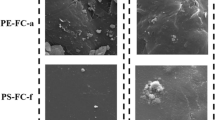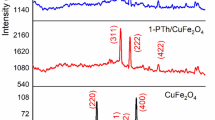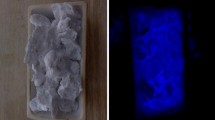Abstract
The waste effluents, such as microplastics, present in the drinking water led to health-related issues for humans and animals. Among various plastic materials, low-density polyethylene (LDPE) in the form of microplastic is one of the major sources of environmental pollution. Thus, there is an urgent need to control pollution due to microplastics for environmental sustainability and the human life cycle. Here, we propose an approach to the degradation of LDPE by using the photocatalysis reaction process. We have used In2O3-rGO nanocomposite-based metal oxide that exhibited effective photocatalytic degradation of polyethylene films when illuminated under visible light with different time durations of 0, 10, 20, 30, 40, and 50 h. A substantial variation in surface morphology with pattern formation supports the degradation behavior of visible light-treated films. The XRD results confirm the purity and orthorhombic crystal structure. The Raman measurement results show characteristic modes and reveal the semi-crystalline nature of the films; however, the crystallinity of the films first increases with an increase in illumination time up to 30 h and then decreases. FTIR results indicate variation in the stretching and bending of C–C and CH2 modes in the films, justifying the degradation of LDPE. The thermogravimetric analysis shows a maximum weight loss (99.47%) of the film exposed to visible light for 50 h. The possible mechanism of polyethylene degradation by In2O3–rGO under visible light illumination is also explained.








Similar content being viewed by others
Data availability
The data will be provided on request.
References
MacArthur DE (2017) Beyond plastic waste. Science (80-. ) 358:843. https://doi.org/10.1126/science.aao6749
Hahladakis JN, Velis CA, Weber R, Iacovidou E, Purnell P (2018) An overview of chemical additives present in plastics: migration, release, fate and environmental impact during their use, disposal and recycling. J Hazard Mater 344:179–199. https://doi.org/10.1016/j.jhazmat.2017.10.014
Kiran BR, Kopperi H, Venkata MS (2022) Micro/nano-plastics occurrence, identification, risk analysis and mitigation: challenges and perspectives. Rev Environ Sci Biotechnol 21:169–203. https://doi.org/10.1007/s11157-021-09609-6
Qiana N, Gao X, Lang X, Deng H, Bratu TM, Chen Q, Stapleton P, Yan B, Mina W (2024) Rapid single-particle chemical imaging of nanoplastics by SRS microscopy. Chem Environ Sci. https://doi.org/10.1073/pnas.230058212
Campanale C, Massarelli C, Savino I, Locaputo V, Uricchio VF (2020) A detailed review study on potential effects of microplastics and additives of concern on human health. Int J Environ Res Public Health. https://doi.org/10.3390/ijerph17041212
Dey TK, Uddin ME, Jamal M (2021) Detection and removal of microplastics in wastewater: evolution and impact. Environ Sci Pollut Res 28:16925–16947. https://doi.org/10.1007/s11356-021-12943-5
Ageel HK, Harrad S, Abdallah MAE (2022) Occurrence, human exposure, and risk of microplastics in the indoor environment. Environ Sci Process Impacts 24:17–31. https://doi.org/10.1039/d1em00301a
Yang Y, Yang J, Jiang L (2016) Comment on a bacterium that degrades and assimilates poly(ethylene terephthalate). Science (80-. ) 353:759. https://doi.org/10.1126/science.aaf8305
Lee QY, Li H (2021) Photocatalytic degradation of plastic waste: a mini review. Micromachines 12:907. https://doi.org/10.3390/mi12080907
Venkataramana C, Botsa SM, Shyamala P, Muralikrishna R (2021) Photocatalytic degradation of polyethylene plastics by NiAl2O4 spinels-synthesis and characterization. Chemosphere 265:129021. https://doi.org/10.1016/j.chemosphere.2020.129021
Nabi I, Bacha AUR, Li K, Cheng H, Wang T, Liu Y, Ajmal S, Yang Y, Feng Y, Zhang L (2020) Complete photocatalytic mineralization of microplastic on TiO2 nanoparticle film. iScience 23:101326. https://doi.org/10.1016/j.isci.2020.101326
Cai L, Wang J, Peng J, Wu Z, Tan X (2018) Observation of the degradation of three types of plastic pellets exposed to UV irradiation in three different environments. Sci Total Environ 628–629:740–747. https://doi.org/10.1016/j.scitotenv.2018.02.079
Tofa TS, Kunjali KL, Paul S, Dutta J (2019) Visible light photocatalytic degradation of microplastic residues with zinc oxide nanorods. Environ Chem Lett 17:1341–1346. https://doi.org/10.1007/s10311-019-00859-z
Tofa TS, Ye F, Kunjali KL, Dutta J (2019) Enhanced visible-light photodegradation of microplastic fragments with plasmonic platinum/zinc oxide nanorod photocatalysts. Catalysts 9:819. https://doi.org/10.3390/catal9100819
Llorente-García BE, Hernández-López JM, Zaldívar-Cadena AA, Siligardi C, Cedillo-González EI (2020) First insights into photocatalytic degradation of HDPE and LDPE microplastics by a mesoporous N-TiO2 coating: Effect of size and shape of microplastics. Coatings 10:658. https://doi.org/10.3390/coatings10070658
Gupta A, Lakshmi YN, Manivannan R, Noyel VS (2017) Visible range photocatalysts for solid-phase photocatalytic degradation of polyethylene and polyvinyl chloride. J Chil Chem Soc 62:3393–3398. https://doi.org/10.4067/S0717-97072017000100018
Ali SS, Qazi IA, Arshad M, Khan M, Voice TC, Mehmood CT (2016) Photocatalytic degradation of low density polyethylene (LDPE) films using titania nanotubes, Environ. Nanotechnology. Monit Manag 5:44–53. https://doi.org/10.1016/j.enmm.2016.01.001
Kamalian P, Khorasani SN, Abdolmaleki A, Karevan M, Khalili S, Shirani M, Neisiany RE (2020) Toward the development of polyethylene photocatalytic degradation. J Polym Eng 40(2):181–191. https://doi.org/10.1515/polyeng-2019-0230
Tejaswini MSSR, Pathak P (2023) In-situ photocatalytic degradation of low-density polyethylene: A pathway towards eco-sustainability and circular economy. Sust Chemi and Pharm 36:101320. https://doi.org/10.1016/j.scp.2023.101320
Kaewkam P, Kanchanapaetnukul A, Khamyan J, Phadmanee N, Lin KYA, Kobwittaya K, Sirivithayapakorn S (2022) UV-assisted TiO2 photocatalytic degradation of virgin LDPE films: Effect of UV-A, UV-C, and TiO2. J Environ Chem Eng 10:108131. https://doi.org/10.1016/j.jece.2022.108131
Dashairya L, Sharma M, Basu S, Saha P (2019) SnS2/rGO based nanocomposite for efficient photocatalytic degradation of toxic industrial dyes under visible-light irradiation. J Alloys Compd 774:625–636. https://doi.org/10.1016/j.jallcom.2018.10.008
Devi P, Singh JP (2021) Visible light induced selective photocatalytic reduction of CO2 to CH4 on In2O3-rGO nanocomposites. J CO2 Util 43:101376. https://doi.org/10.1016/j.jcou.2020.101376
Sagadevan S, Lett JA, Weldegebrieal GK, Garg S, Oh WC, Hamizi NA, Johan MR (2021) Enhanced photocatalytic activity of rGO-CuO nanocomposites for the degradation of organic pollutants. Catalysts 11:1008. https://doi.org/10.3390/catal11081008
Birhan D, Tekin D, Kiziltas H (2022) Thermal, photocatalytic, and antibacterial properties of rGO/TiO2/PVA and rGO/TiO2/PEG composites. Polym Bull 79:2585–2602. https://doi.org/10.1007/s00289-021-03914-4
Verma R, Singh S, Dalai MK, Saravanan M, Agrawal V, V, Srivastava A. K. (2017) Photocatalytic degradation of polypropylene film using TiO2-based nanomaterials under solar irradiation. Mater Des 133:10–18. https://doi.org/10.1016/j.matdes.2017.07.042
Devi P, Malik K, Arora E, Bhattacharya S, Kalendra V, Lakshmi KV, Verma A, Singh JP (2019) Selective electrochemical reduction of CO2 to CO on CuO/In2O3 nanocomposites: Role of oxygen vacancies. Catal Sci Technol 9(1):5339–5349. https://doi.org/10.1039/c9cy01396b
Devi P, Singh A, Malik K, Verma A, Bhattacharya S, Singh JP (2021) Regeneration of Catalytic Activity of CuO–Cu2O/In2O3 Nanocomposite towards Electrochemical Reduction of CO2 by UV Light Treatment. J Electrochem Soc 168:066518. https://doi.org/10.1149/1945-7111/ac0a26
Hiejima Y, Kida T, Takeda K, Igarashi T, Nitta KH (2018) Microscopic structural changes during photodegradation of low-density polyethylene detected by Raman spectroscopy. Polym Degrad Stab 150:67–72. https://doi.org/10.1016/j.polymdegradstab.2018.02.010
Rull F, Prieto AC, Casado JM, Sobron F, Edwards HGM (1993) Estimation of crystallinity in polyethylene by Raman spectroscopy. J Raman Spectrosc 24:545–550. https://doi.org/10.1002/jrs.1250240813
Giordano D, Russell JK, González-García D, Bersani D, Dingwell DB, Del Negro C (2020) Raman spectroscopy from laboratory and proximal to remote sensing: A tool for the volcanological sciences. Remote Sens 12:1–17. https://doi.org/10.3390/rs12050805
Strobl GR, Hagedorn W (1978) Raman Spectroscopic Method for Determining the Crystallinity of Polyethylene. AIP Conf Proc 16:1181–1193. https://doi.org/10.1002/pol.1978.180160704
Paradkar RP, Sakhalkar SS, He X, Ellison MS (2003) Estimating crystallinity in high density polyethylene fibers using online Raman spectroscopy. J Appl Polym Sci 88:545–549. https://doi.org/10.1002/app.11719
Thomas RT, Sandhyarani N (2013) Enhancement in the photocatalytic degradation of low density polyethylene-TiO2 nanocomposite films under solar irradiation. RSC Adv 3:14080–14087. https://doi.org/10.1039/c3ra42226g
Li S, Xu S, He L, Xu F, Wang Y, Zhang L (2010) Photocatalytic degradation of polyethylene plastic with polypyrrole/TiO2 nanocomposite as photocatalyst. Polym - Plast Technol Eng 49:400–406. https://doi.org/10.1080/03602550903532166
Aboulkas A, Harfi KE, Bouadili AE (2010) Thermal degradation behaviors of polyethylene and polypropylene. Part I: Pyrolysis kinetics and mechanisms. Energy Convers Manag 51:1363–1369. https://doi.org/10.1016/j.enconman.2009.12.017
Acknowledgements
Dr. Pinki Devi would like to acknowledge the Indian Institute of Technology Delhi for financial support.
Author information
Authors and Affiliations
Corresponding author
Ethics declarations
Conflict of interests
The authors declare to have no known competing financial interests or personal relationships that could have appeared to influence the work reported in this manuscript.
Additional information
Publisher's Note
Springer Nature remains neutral with regard to jurisdictional claims in published maps and institutional affiliations.
Highlights
• The In2O3-rGO nanocomposite catalyst is a highly efficient photocatalyst for the degradation of polyethylene.
• FESEM measurements revealed that substantial variation in surface morphology with patterning formation supports the degradation of polyethylene film.
• RAMAN and FTIR measurements indicate that variation in the stretching and bending of C-C and CH2 modes assist in polyethylene degradation.
• The TGA measurements revealed that the weight loss % increases with the increase of visible light irradiation on polyethylene/In2O3-rGO nanocomposites, and the maximum weight loss of 99.47% is obtained for the PE-50H film.
• The mechanism pathway for photocatalytic degradation of polyethylene by In2O3-rGO nanocomposite is explained.
Rights and permissions
Springer Nature or its licensor (e.g. a society or other partner) holds exclusive rights to this article under a publishing agreement with the author(s) or other rightsholder(s); author self-archiving of the accepted manuscript version of this article is solely governed by the terms of such publishing agreement and applicable law.
About this article
Cite this article
Devi, P., Soni, A. & Singh, J.P. Highly effective In2O3-rGO catalyst for the photocatalytic degradation of polyethylene under visible light. J Polym Res 31, 152 (2024). https://doi.org/10.1007/s10965-024-04002-7
Received:
Accepted:
Published:
DOI: https://doi.org/10.1007/s10965-024-04002-7




